The Aerospace History Blog - Page 05

Post 030
Samara Space Centre
This brochure from 2008 illustrates the vast experience of the
Soviet/Russian spaceflight industry. Up until then, 1,730 Soyus
rockets had been launched from the Samara Space Center. The
pride in this achievement can be heard over and over again in the
brochure. The rockets used are described and illustrated in
explanatory sectional drawings.
In 2008 the cooperation with the European Space Agency ESA just
started. Russian Soyus ST-type rockets are now being launched
from the Kourou space center. This rocket and the launch facilities
for it in French Guiana are also dealt with in a chapter.
If you consider this broad base of space expertise, it is sad that so
little research is being carried out by Russia with space probes in
the solar system today.

Posted by Uwe W. Jack
The Russian 2008 brochure with information
about Samara rockets and the Space Flight
Center.
(click to see the brochure - the file may not be
modified - commercial use is prohibited.)
Post 031
Landing an intact aircraft on the belly
An interesting episode from World War II is illustrated by four
photos. The story was told to me by a now deceased pilot of the
KG 51 Kampfgeschwader.
The 10th Staffel of Kampfgeschwader 51 received orders in
the summer of 1942 to attack a Russian railway station on the
Eastern Front. For this purpose, the Junkers Ju 88 were also
loaded with 1,000 kg bombs. The copilot Werner Heiser had just
received a film for his new camera. He used it to take a picture of
one aircraft ready for take-off before the mission. The approach
was uneventful. Heiser photographed the Ju 88 coded 9K + CU
flying next to his machine. The railway station was easy to find.
There was no anti-aircraft defense and no enemy fighters. The
bombs hit the target well. However, on the return flight, Soviet
fighters appeared and attacked the 9K + CU, which was flying at
the end of the formation. The crew was injured, the pilot so badly
that he passed out.
The comrades were encouraged over the radio. They
absolutely had to fly the plane over the front line. After flying over
the front, the injured copilot was able to hold the Ju 88 in the air for
some time, but then radioed that he had to belly land the machine.
The flat Russian plains offered ideal terrain for a belly landing.
Werner Heiser's crew maneuvered next to the other Junkers and
talked the copilot over the radio down to the ground. All of them
looked at the damaged aircraft with the wounded comrades with
such concentration that they did not notice that their Junkers
without extended undercarriage were also about to land. Only a
few meters after the damaged aircraft hit the ground, the intact
Junkers Ju 88 landed on its belly too.
Since they had badly damaged an airworthy aircraft through
carelessness, the crew was threatened with a court martial. As a
souvenir, Werner Heiser had himself photographed sitting on the
cockpit of the belly-landed Ju 88. The two wounded comrades
were flown to the hospital with a Fieseler Storch. There was no
court martial, a few days later they were already flying again their
next combat mission.
Unfortunately, the new camera didn't take good pictures, and
there weren't many details to be seen on the tiny prints. A better
photo, probably taken the day after landing, which can be found on
militaryimages.net, shows Werner Heiser sitting on the engine of
his Junkers, with the propeller in his arms. This photo was taken
by an unknown comrade.

Posted by Uwe W. Jack
After the belly-landing, the copilot of the
Junkers Ju 88 posed for a photo sitting on
the cockpit.
(click to enlarge - the file may not be
modified - commercial use is prohibited.)

A KG 51 Junkers Ju 88, loaden with a bomb of 1,000 kg
waits for the crew before the mission. Note large
KG 51 badge and white bands arround engines.
(click to enlarge - the file may not be modified -
commercial use is prohibited.)
Junkers Ju 88 9K+CU in flight towards a soviet railway station.
The fuselage band was yellow, while the C was in white like the
prop spinner. Here the engine bands seems to be yellow.
(click to enlarge - the file may not be modified - commercial use
is prohibited.)

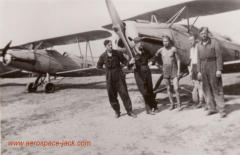
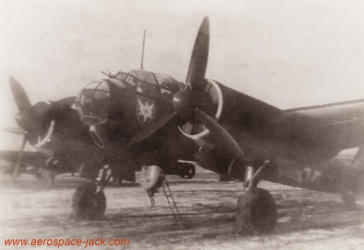
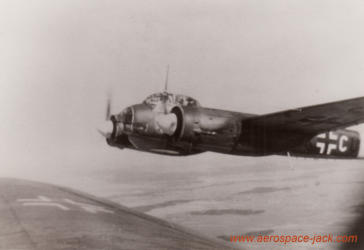
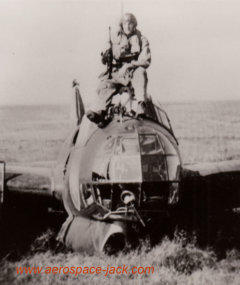
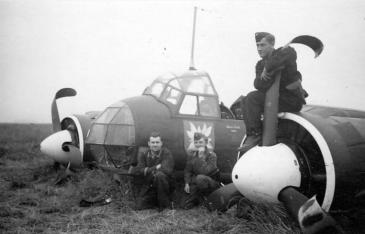
Werner Heiser standing at left during his
flight training with comrades and Gotha
Go 145 biplanes..
(click to enlarge - the file may not be
modified - commercial use is prohibited.)
An interesting discovery from the internet:
Werner Heiser sitting the next day on the engine
of his belly landed Ju 88 with white prop spinner
and engine band.
(click to link to www.militaryimages.net)

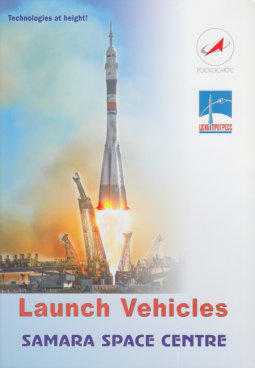

One example of the graphics
presented in the brochure - here
the Soyus U launch vehicle.

Post 033
A postcard picture of the Focke-Wulf Fw 56. Despite the character
looks like a “J”, this aircraft is coded D-ISOT. It is the first prototype.
(Click to enlarge - the file may not be modified - commercial use is
prohibited.)
Luftwaffe’s secret start with trainer
aircraft
In 1933 the National Socialists took power in Germany and made
more money available for the secret build-up of air forces that had
already begun in the years before. As a training aircraft and light
fighter, Kurt Tank designed the Fw 56 at Focke Wulf, which first
flew in November 1933. About 500 aircraft were built.
A little later, Arado's competitor development, the Ar 76, came on.
It flew for the first time in April 1934. The Luftwaffe carried out a
flight competition with this competitors (plus Henschel Hs 121 and
Hs 125), which the Fw 56 won. 189 aircraft were built of the Arado
Ar 76.

Posted by Uwe W. Jack

Post 034
A calendar picture of a Bücker Bü 133 showing the emblem of Jagdfliegerschule 2
(Fighter School 2) at Schleissheim near Munich. (Click to enlarge - the file may not be
modified - commercial use is prohibited.)
An aircraft for future Luftwaffe fighter
pilots
Even before the Luftwaffe was officially founded on February 26,
1935, a flight school for fighter pilots was established in
Schleissheim, north of Munich, in 1934. In 1936 this school was
closed and in 1939 it was re-established as the Jagdfliegerschule 2
(JFS 2) fighter pilot school. The color photo of the school's Bücker
Bü 133 was probably made at this time.
The Luftwaffe's trainer planes were marked differently at different
times. At first they were given civil registrations, for example D-
EFPR for a Bü 133. Then from 1939 a three-digit number, like the
271 in the photo, and from around 1941 a Luftwaffe
Stammkennzeichen (regular registration), such as DE + CB for a
Bü 133. Often the training planes were then also provided with
camouflage paint.

Posted by Uwe W. Jack

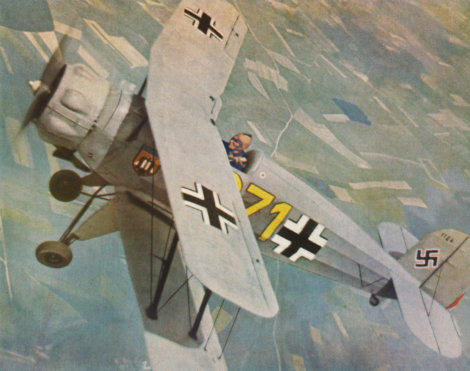
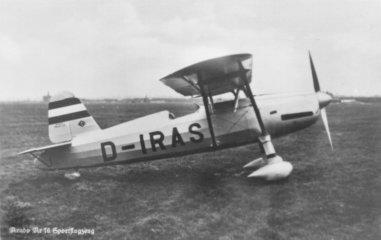
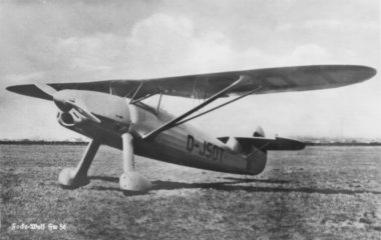
A postcard picture of the Arado Ar 76. The D-IRAS was the second
prototype.
(Click to enlarge - the file may not be modified - commercial use is
prohibited.)
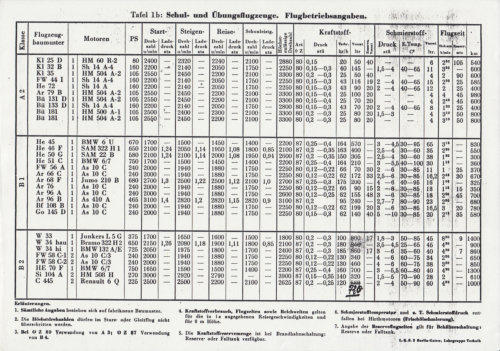
The Luftkriegsschule at Berlin Gatow LKS 2 (Air War Academy) published this
overview over all school aircraft used by the Luftwaffe with technical data.
(Click to enlarge - the file may not be modified - commercial use is prohibited.)
Post 032
“The siren sounds - which aircraft is coming?”
Information leaflet for the residents near Tempelhof airport.
(Click to enlarge - the file may not be modified - commercial use is prohibited.)
Air traffic over Tempelhof circa 1929
The Tempelhof Airport was located in the middle of the city of
Berlin between residential buildings. That is why this facility is
still called Zentralflughafen Tempelhof today (in the US armed
forces after the war: TCA - Tempelhof Central Airport). To warn
the population, a siren always sounded when an aircraft was
approaching.
For the information of the residents there this leaflet was used,
which explained which type of aircraft was currently in the air.

Posted by Uwe W. Jack

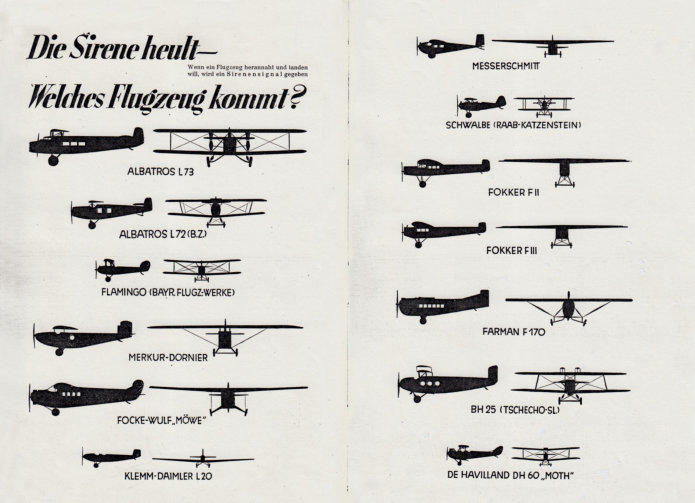
Post 035
Twelve german aircraft of the pre-war years in a mix of civil and military types.
(Click to enlarge - the file may not be modified - commercial use is prohibited.)
German aircraft of 1939
The Reichsluftfahrtministerium (Aviation Ministry) published in
1939 some official photographs of well known aircraft types:
- Arado Ar 79
- Dornier Do 18
- Fieseler Fi 156 “Storch”
- Focke-Wulf Fw 44 “Stieglitz”
- Gotha Go 150
- Heinkel He 51
- Henschel Hs 123
- Henschel Hs 126
- Junkers Ju 52/3m
- Junkers Ju 90
- Messerschmitt Bf 109
- Siebel Fh 104

Posted by Uwe W. Jack












